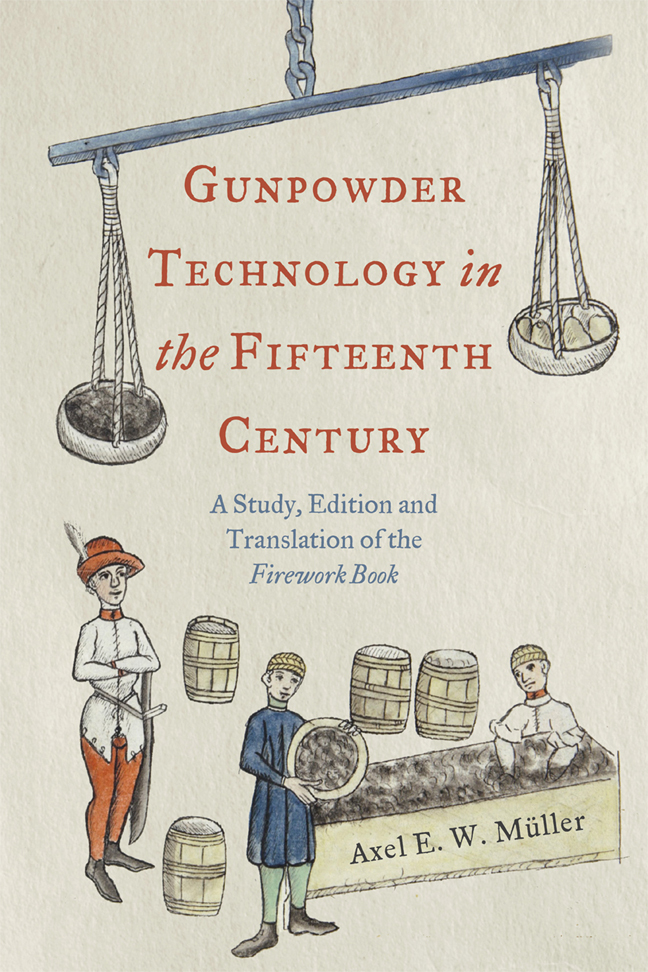341 results
Index
-
- Book:
- Gunpowder Technology in the Fifteenth Century
- Published by:
- Boydell & Brewer
- Published online:
- 21 February 2024
- Print publication:
- 16 January 2024, pp 373-378
-
- Chapter
- Export citation
List of Figures
-
- Book:
- Gunpowder Technology in the Fifteenth Century
- Published by:
- Boydell & Brewer
- Published online:
- 21 February 2024
- Print publication:
- 16 January 2024, pp vi-vi
-
- Chapter
- Export citation
3 - The Leeds Firework Book
-
- Book:
- Gunpowder Technology in the Fifteenth Century
- Published by:
- Boydell & Brewer
- Published online:
- 21 February 2024
- Print publication:
- 16 January 2024, pp 56-79
-
- Chapter
- Export citation
Frontmatter
-
- Book:
- Gunpowder Technology in the Fifteenth Century
- Published by:
- Boydell & Brewer
- Published online:
- 21 February 2024
- Print publication:
- 16 January 2024, pp i-iv
-
- Chapter
- Export citation
5 - Analysis of the Text
-
- Book:
- Gunpowder Technology in the Fifteenth Century
- Published by:
- Boydell & Brewer
- Published online:
- 21 February 2024
- Print publication:
- 16 January 2024, pp 304-344
-
- Chapter
- Export citation
2 - The Use and Reception of the Firework Book
-
- Book:
- Gunpowder Technology in the Fifteenth Century
- Published by:
- Boydell & Brewer
- Published online:
- 21 February 2024
- Print publication:
- 16 January 2024, pp 35-55
-
- Chapter
- Export citation
Bibliography
-
- Book:
- Gunpowder Technology in the Fifteenth Century
- Published by:
- Boydell & Brewer
- Published online:
- 21 February 2024
- Print publication:
- 16 January 2024, pp 349-372
-
- Chapter
- Export citation
Acknowledgements
-
- Book:
- Gunpowder Technology in the Fifteenth Century
- Published by:
- Boydell & Brewer
- Published online:
- 21 February 2024
- Print publication:
- 16 January 2024, pp vii-viii
-
- Chapter
- Export citation
Contents
-
- Book:
- Gunpowder Technology in the Fifteenth Century
- Published by:
- Boydell & Brewer
- Published online:
- 21 February 2024
- Print publication:
- 16 January 2024, pp v-v
-
- Chapter
- Export citation
Introduction
-
- Book:
- Gunpowder Technology in the Fifteenth Century
- Published by:
- Boydell & Brewer
- Published online:
- 21 February 2024
- Print publication:
- 16 January 2024, pp 1-9
-
- Chapter
- Export citation
Miscellaneous Endmatter
-
- Book:
- Gunpowder Technology in the Fifteenth Century
- Published by:
- Boydell & Brewer
- Published online:
- 21 February 2024
- Print publication:
- 16 January 2024, pp 379-380
-
- Chapter
- Export citation
Conclusion
-
- Book:
- Gunpowder Technology in the Fifteenth Century
- Published by:
- Boydell & Brewer
- Published online:
- 21 February 2024
- Print publication:
- 16 January 2024, pp 345-348
-
- Chapter
- Export citation
4 - The Text of Royal Armouries I.34
-
- Book:
- Gunpowder Technology in the Fifteenth Century
- Published by:
- Boydell & Brewer
- Published online:
- 21 February 2024
- Print publication:
- 16 January 2024, pp 80-303
-
- Chapter
- Export citation

Gunpowder Technology in the Fifteenth Century
- A Study, Edition and Translation of the Firework Book
-
- Published by:
- Boydell & Brewer
- Published online:
- 21 February 2024
- Print publication:
- 16 January 2024
1 - The Firework Book Tradition
-
- Book:
- Gunpowder Technology in the Fifteenth Century
- Published by:
- Boydell & Brewer
- Published online:
- 21 February 2024
- Print publication:
- 16 January 2024, pp 10-34
-
- Chapter
- Export citation
Patterns of residential differentiation and labor control at Baking Pot and Lower Dover in the Belize River Valley
-
- Journal:
- Ancient Mesoamerica / Volume 34 / Issue 3 / Fall 2023
- Published online by Cambridge University Press:
- 28 March 2024, e9
- Print publication:
- Fall 2023
-
- Article
-
- You have access
- Open access
- HTML
- Export citation
An approach for collaborative development of a federated biomedical knowledge graph-based question-answering system: Question-of-the-Month challenges
-
- Journal:
- Journal of Clinical and Translational Science / Volume 7 / Issue 1 / 2023
- Published online by Cambridge University Press:
- 14 September 2023, e214
-
- Article
-
- You have access
- Open access
- HTML
- Export citation
Do values and political attitudes affect help-seeking? Exploring reported help-seeking for mental health problems in a general population sample using a milieu framework
-
- Journal:
- Epidemiology and Psychiatric Sciences / Volume 32 / 2023
- Published online by Cambridge University Press:
- 04 August 2023, e49
-
- Article
-
- You have access
- Open access
- HTML
- Export citation
Shell Games: A Middle Preclassic Shell Deposit at the Minor Center of Tutu Uitz Na in the Upper Belize River Valley
-
- Journal:
- Latin American Antiquity , First View
- Published online by Cambridge University Press:
- 02 August 2023, pp. 1-8
-
- Article
- Export citation
Cenozoic evolution of the Tripolitza carbonate platform in the Tethyan realm: new age constraints on deposition, diagenesis, metamorphism and nappe emplacement based on U-Pb and Rb-Sr dating (External Hellenides, Crete)
-
- Journal:
- Geological Magazine / Volume 160 / Issue 7 / July 2023
- Published online by Cambridge University Press:
- 20 July 2023, pp. 1282-1300
-
- Article
- Export citation



